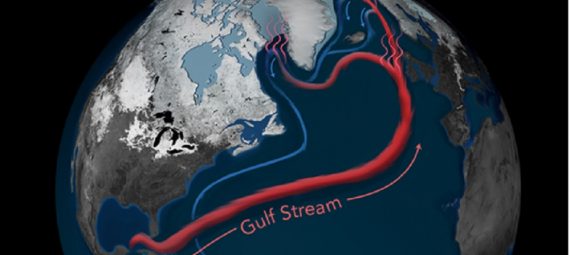THERESA ZETTL
Back when I was student at school, I had a geography teacher in 6th grade that would constantly warn about the gulf stream drying out. I had the same teacher for two years in preparation of my A-levels in geography, and she warned in 2007 even more than a few years before, that the gulf stream will dry out. This year, 14 years after I passed my A-levels I often think of her and her words.
What is the gulf stream?
The Gulf Stream carries warm Atlantic water from the Caribbean to Europe. That is why winters in Europe are not as cold as air masses warm up, providing a milder climate than in North America at comparable latitudes. Off Florida, for example, it travels at 32 million cubic metres of water per second, about 30 times as much as all the rivers on earth transport together. The palm trees on the British south coast would also be unthinkable without the Gulf Stream. Driven by winds, the Earth’s rotation and differences in water density, the warm water flows through the Atlantic and towards the Arctic.
How is it possible to measure, if and when the Gulf stream will dry out?
Only since 2004 has it been possible to measure the strength of the Gulf Stream system directly, via thousands of drifting buoys along its path. To determine what it looked like decades or centuries earlier, proxy data must be used. These are, for example, the water temperatures recorded since around 1870, but above all the seabed, in whose sediments the climatic past is recorded layer by layer. Even before the turn of the millennium, Professor Stefan Rahmstorf of the Potsdam Institute for Climate Impact Research (PIK) predicted that the Gulf Stream could weaken or even dry up because of global climate change. Today, the flow is weaker than ever, but it does not behave linearly.
But what happens if the Gulf Stream really stops flowing?
According to experts, the consequences can hardly be estimated: The water level would rise, especially in North America, and the marine ecosystems would suffer from the probably decreasing oxygen content. In Europe, severe storms are expected – there has even been talk of a new ice age.
Nevertheless, more data is lacking, because reliable conclusions can only be drawn from many years of observations. Until then, researchers – any my former geography teacher – will continue to look at the Gulf Stream with a concerned eye.
Author Profile
-
Co-Founder of European Liberals for Reform
Chairperson of ELfR Working Group Health
ALDE Individual Members Steering Committee Member (2022-2023)
Social Media & Digital Marketing Expert, Blogger
Favorite Topics: Health, Society, LGBTQI
Latest entries
 Elections13/04/2022Presidential elections in France 2022
Elections13/04/2022Presidential elections in France 2022 Human Rights22/03/2022ELfR to support Manifesto for inclusive gender-based violence law
Human Rights22/03/2022ELfR to support Manifesto for inclusive gender-based violence law EU07/03/2022Five possible scenarios for the outcome of the Ukraine war
EU07/03/2022Five possible scenarios for the outcome of the Ukraine war Ukraine06/03/2022ELfR starts petition to nominate Volodymyr Zelenski for Sakharov Prize
Ukraine06/03/2022ELfR starts petition to nominate Volodymyr Zelenski for Sakharov Prize
Post Disclaimer
The opinions expressed by the author of this post do not necessarily represent the opinions and policies of ELfR.


Additional information on the subject from the French CNRS (Centre National de la Récherche Scientifique) https://news.cnrs.fr/articles/why-the-gulf-stream-is-a-misnomer